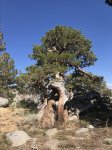

Here is a good example of design without enough consideration of nature and working on auto pilot. I don't blame anyone in particular and I do it myself, but it helps to at least be aware of it when considering naturalistic or ''natural'' looking styles.
In the ''designed'' tree you can see what 99.9% of people do (and that includes all of the ''masters'' ) when they shape the crown of the tree. I won't say 100% because there may be someone who does not do this or seeks to avoid it? They have it firmly fixed in their DNA that we must bring branches down, that we must have a ''main'' branch that dictates the flow of the tree and that this branch must be end in a point and that there must be some kind of triangle to the shape of the crown regardless of the base of the tree. The truth is that real weather beaten trees are completely dependant of the forces of nature - especially the wind - and they usually do not conform to our pre-conceived shallow concepts of beauty. When we start to do away with these concepts and start to really look and appreciate that nature is the true master, we might then start to free up the possibilities which have been either frowned upon or not even realized till now. I have not seen anyone talk about this - not even W. Pall!
In the first example it is very obvious that no consideration at all was given to naturalism, and yet again we have fallen back on text book design rather than try to speculate what really would happen if such a tree were in the mountains and have to deal with a harsh existence and all the weather coming from one main direction. The denser the canopy of this tree becomes the more distant from naturalism it will go. I think it's time we give more thought to the formation of the base of the tree as it presents before we go ahead and blindly shape the crown as we have a million times before. This is the very essence of contrivance with the result of artificiality. No matter how wild or convoluted the trunk and main branches may be we feel the urgent need to ''tame'' the tree by putting a green triangle on top of it.
View attachment 168344
View attachment 168345[/QUOTE]
The thing is, they do grow in classical bonsai shapes!















